Surfperch
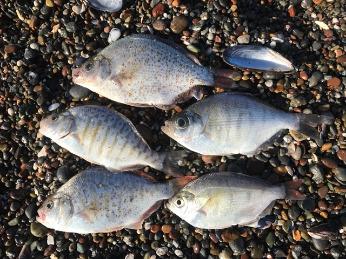 Clockwise from the lower left: Redtail Surfperch, Barred Surfperch, Calico Surfperch, Walleye Surfperch, and Silver Surfperch. CDFW photo by Matt Wong.
Clockwise from the lower left: Redtail Surfperch, Barred Surfperch, Calico Surfperch, Walleye Surfperch, and Silver Surfperch. CDFW photo by Matt Wong.
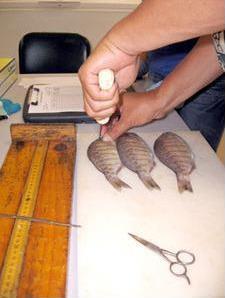
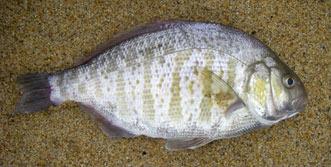 Barred surfperch. CDFW photo by Ken Oda.
Barred surfperch. CDFW photo by Ken Oda.
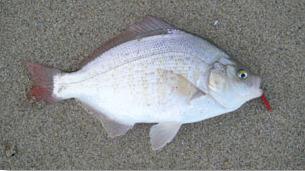 Redtail surfperch. CDFW photo by Ken Oda.
Redtail surfperch. CDFW photo by Ken Oda.
The surfperch family refers to fishes with compressed and oval- to oblong-shaped bodies. The dorsal fins are continuous, meaning not notched, and usually have 9 to 11 spines and 19 to 28 soft rays. The anal fin has three spines and anywhere from 15 to 35 soft rays. The caudal (tail) fin is forked. Base coloration is usually silver, and some species have stripes or bars, which may be dependent on the time of year (breeding vs. non-breeding coloration) and whether the fish is a juvenile or adult. Maximum fish length per species ranges from 4 to 18 inches. Within the family Embiotocidae, some species are called surfperch, and others are called seaperch or perch, primarily depending on their habitat. True surfperch species are located mainly in or near the sandy beach surf zone, and seaperches and perches live in kelp beds and deeper water. The two surfperch pictured to the right are the barred surfperch (top) and the redtail surfperch.
Surfperch are viviparous(livebearers). This means that fertilization is internal and embryos are nurtured and developed inside of the female. They usually produce between 1 to 113 live young per litter. The young are released as fully-formed miniature versions of the adults.
Species Identification
Kingdom: Animalia
Phylum: Chordata
Class: Actinopterygii
Order: Perciformes
Family: Embiotocidae (Surfperches)
- Common Surfperches of California ID sheet (PDF)
Provides color photos and key features for identifying barred surfperch, redtail surfperch, calico surfperch, black perch, rubberlip seaperch, pile perch, white seaperch, shiner perch, silver surfperch, walleye surfperch, striped seaperch and rainbow surfperch.
- Marine Species Portal
Provides in-depth information for some of the most popular species of surfperch, including silver surfperch, walleye surfperch, shiner perch, redtail surfperch, rubberlip seaperch, and barred surfperch.
Surfperch Studies
Surfperch studies in central and southern California are focused on barred surfperch, the most common species harvested recreationally along sandy beaches in this region. Field surveys are conducted to obtain a variety of information including angler catch, effort, and daily fishing trends, associated species in the catch, and biological information on length, weight, age, and reproductive condition of surfperch.
Age-Growth Study
How fast does a surfperch grow? Does the rate of growth change with latitude for a particular species? These questions will be answered by comparing the length of a fish caught in a specific location with its age, which is determined by examining its otolith. Otoliths are small bones located in the fish's head. They develop concentric rings as the fish matures, much like the rings in a tree trunk. By counting the otolith rings under a microscope, biologists can determine a fish's age.
The Project began collecting surfperch embryos in 2012 in an effort to learn more about the early life history dynamics of the live-bearing surfperch family. By examining the rings embedded in the otoliths (ear bones)), we can estimate the age in days as well as the daily growth history. With this information, along with the age in years of adult females, we hope to determine whether maternal age influences the timing of birth and growth rate during the embryonic phase. Since these factors have previously been linked to survival, this study may help us understand the importance of maintaining older fish in a population.
Project Resources: Surfperch
- How to Externally Sex Surfperch (PDF)
- Fish Bulletins
- The Barred Surfperch (Ampistichus argenteus Agassis) in Southern California (1960)
California Department of Fish and Wildlife Fish Bulletin 109
This bulletin provides a snapshot of the Southern California surf fishery in the 1950s, and discusses the following: aging methods; using different structures; fecundity; length-at-age; tagging and movement. Photos are also included. It was produced by three CDFW biologists to fill data gaps in the popular surf-zone fishery for what is still the most often-caught species in the sandy surf.
- The Marine Recreational Fishery in Northern and Central California (pages 111-139) (1995)
California Department of Fish and Wildlife Fish Bulletin 176
This bulletin provides an in-depth analysis of recreational fishing trends for a variety of species, with special attention given to the surfperches. It outlines how species composition has changed over time from 1958 to 1968. It includes a discussion of how changes in the California Current might affect fisheries.
Collaborative Studies: True Smelts
Along with the California Beach Fishermen's Association and H.T. Harvey and Associates, the Project received a small grant from Collaborative Fisheries Research West to study the night smelt population in Humboldt and Del Norte counties in 2014. Working with several commercial night smelt fishermen, we were able to obtain monthly regional fish samples across the entire north coast region in an effort to better understand aspects of night smelt life history. Additionally, we documented fish species commonly caught as bycatch while targeting night smelt in an effort to examine potential ecosystem impacts of the fishery.
Results from this one-year study were successful in improving our base of knowledge for night smelt. The population is clearly dominated by larger male fish; however, further research is needed to resolve several outstanding questions concerning the life history of this species. In observing commercial fishing activity, we documented relatively little bycatch in the fishery overall, and that the primary bycatch species were redtail surfperch (Amphistichus rhodoterus) and Pacific mole crab (Emerita analoga), the majority of which were released in live condition.
Full technical report: Collaborative Research on the Spawning Population of Night Smelt (Spirinchus starksi) in Humboldt and Del Norte Counties, California (PDF) - April 2015
Surf Fish Population Study
Surf fishes form the basis of a very popular recreational fishery in southern California. In 2008 an estimated 576,000 angler trips were made by nearshore anglers who caught surfperch, croakers, or California corbina, according to RecFIN data.
Despite the predominance of sandy beaches in the Southern California Bight (SCB), relatively little information exists on the surf zone fish community. In particular, spatial and temporal abundance information on surf fishes is lacking. The objectives of this study are to determine changes in surf fish abundances over time, among sites with differing exposure to wave action, and relative to tide heights and tidal movements. Results from this study will be compared to similar CDFW studies completed in the 1950s and 1990s.
Study Methods
Monthly beach seine sets at four sites (Bolsa Chica State Beach, Seal Beach, Belmont Shore, Hermosa Beach) within the SCB were conducted from May 2007 through September 2009. Beach seines are fishing nets with floats at the top and weights at the bottom to keep them open. Nets are set in about 10 feet of water and dragged to shore along the ocean bottom. Every fish caught in the net was identified, measured, and released. Sport fishes of interest (California corbina, spotfin croaker, yellowfin croaker, barred surfperch, and walleye surfperch) that were large enough to hold a t-bar tag and appeared to be in good condition were tagged prior to release. You may view pictures of these and other common surf zone fishes (PDF).
What to do if you catch a tagged fish
Each tag has a unique ID number and a CDFW phone number for anglers to call when they catch a tagged fish. Anglers are asked to provide the following information when reporting a tagged fish:
- tag number
- date caught
- general location or GPS coordinates
- total length (estimated or measured)
- any additional information
Flyers (PDF) have been posted at local bait shops and piers to inform anglers about the study. Results from this tagging study will help determine the seasonal and annual movement patterns of these fishes.
Findings to Date
As of September 2009, project staff have completed 386 hauls and caught 31,631 fish consisting of 47 species. The average number of fish per haul was around 82, but as many as 2,200 fish have been caught in a single haul.
List of fish species caught from May 2007 to September 2009
| Rank
|
Species
|
Scientific Name
|
Abundance
|
| 1
|
queenfish
|
Seriphus politus
|
8601
|
| 2
|
Pacific sardine
|
Sardinops sagax
|
4298
|
| 3
|
yellowfin croaker
|
Umbrina roncador
|
4285
|
| 4
|
walleye surfperch
|
Hyperprosopon argenteum
|
2257
|
| 5
|
topsmelt
|
Atherinops affinis
|
2175
|
| 6
|
California corbina
|
Menticirrhus undulatus
|
1858
|
| 7
|
round stingray
|
Urobatis halleri
|
1830
|
| 8
|
salema
|
Xenistius californiensis
|
1119
|
| 9
|
jacksmelt
|
Atherinopsis californiensis
|
1014
|
| 10
|
spotfin croaker
|
Roncador stearnsii
|
972
|
| 11
|
barred surfperch
|
Amphistichus argenteus
|
507
|
| 12
|
deepbody anchovy
|
Anchoa compressa
|
484
|
| 13
|
white croaker
|
Genyonemus lineatus
|
435
|
| 14
|
bat ray
|
Myliobatis californica
|
244
|
| 15
|
California halibut
|
Paralichthys californicus
|
234
|
| 16
|
shovelnose guitarfish
|
Rhinobatos productus
|
234
|
| 17
|
shiner perch
|
Cymatogaster aggregata
|
228
|
| 18
|
striped mullet
|
Mugil cephalus
|
125
|
| 19
|
jack mackerel
|
Trachurus symmetricus
|
113
|
| 20
|
white seabass
|
Atractoscion nobilis
|
98
|
| 21
|
Pacific barracuda
|
Sphyraena argentea
|
96
|
| 22
|
Pacific chub mackerel
|
Scomber japonicus
|
91
|
| 23
|
leopard shark
|
Triakis semifasciata
|
65
|
| 24
|
California needlefish
|
Strongylura exilis
|
55
|
| 25
|
gray smoothhound
|
Mustelus californicus
|
36
|
| 26
|
barred sand bass
|
Paralabrax nebulifer
|
25
|
| 27
|
barcheek pipefish
|
Syngnathus exilis
|
24
|
| 28
|
white seaperch
|
Phanerodon furcatus
|
21
|
| 29
|
California butterfly ray
|
Gymnura marmorata
|
17
|
| 30
|
Pacific pompano
|
Peprilus simillimus
|
12
|
| 30
|
zebraperch
|
Hermosilla azurea
|
12
|
| 31
|
diamond turbot
|
Pleuronichthys guttulatus
|
9
|
| 31
|
northern anchovy
|
Engraulis mordax
|
9
|
| 32
|
Pacific staghorn sculpin
|
Leptocottus armatus
|
7
|
| 32
|
thornback
|
Platyrhinoidis triseriata
|
7
|
| 33
|
black perch
|
Embiotoca jacksoni
|
6
|
| 33
|
giant kelpfish
|
Heterostichus rostratus
|
6
|
| 34
|
dwarf perch
|
Micrometrus minimus
|
4
|
| 35
|
California grunion
|
Leruresthes tenuis
|
3
|
| 35
|
kelp bass
|
Paralabrax clathratus
|
3
|
| 35
|
pile perch
|
Rhacochilus vacca
|
3
|
| 36
|
hornyhead turbot
|
Pleuronichthys verticalis
|
2
|
| 36
|
Mexican lookdown
|
Selene brevoortii
|
2
|
| 36
|
sargo
|
Anisotremus davidsonii
|
2
|
| 37
|
black croaker
|
Cheilotrema saturnum
|
1
|
| 37
|
bonefish
|
Albula sp. A
|
1
|
| 37
|
speckled sanddab
|
Citharichthys stigmaeus
|
1
|
Tag Recaptures
- 3,270 fish have been tagged
- 18 fish have been recaptured
- 9 barred surfperch
- 3 California corbina
- 2 spotfin croaker
- 4 yellowfin croaker
- The greatest distance between tagging and recovery locations was the eight miles a large spotfin croaker traveled between the south end of Seal Beach and Huntington Beach pier.
Interesting Trends
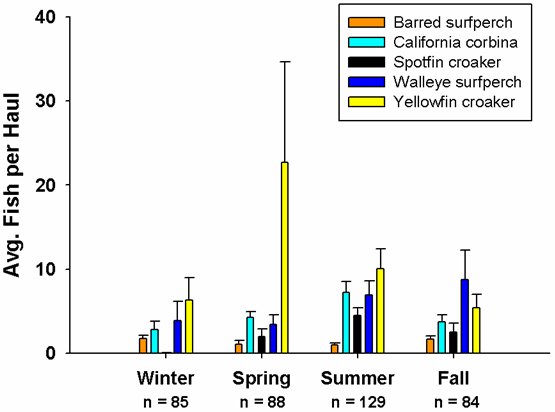 Average CPUE by season for five popular sport fishes, May 2007 through September 2009. Error bars denote one standard error.
Average CPUE by season for five popular sport fishes, May 2007 through September 2009. Error bars denote one standard error.
Barred surfperch abundance remained relatively constant throughout all seasons, while spotfin croaker and California corbina abundances peaked in the summer and were lowest during the winter. Those seasonal differences may be due to inshore-offshore or upcoast-downcoast movements. Subsequent analyses suggest the dramatic increase in yellowfin croaker numbers in the spring was primarily due to increased numbers of young-of-the-year (YOY) in the catch. Increased walleye surfperch abundances in summer and fall were also due to an increase in abundance of YOY.
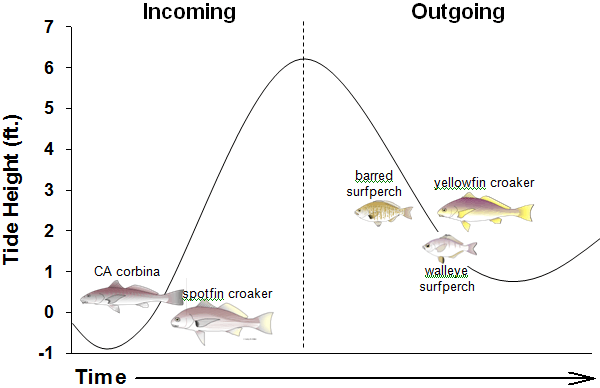 Tide height and flux for five popular sport fishes when CPUE was highest. Fish illustrations provided by Dr. Larry Allen.
Tide height and flux for five popular sport fishes when CPUE was highest. Fish illustrations provided by Dr. Larry Allen.
Although individuals of each species were caught throughout the tide cycle and at all tide heights, California corbina and spotfin croaker were more abundant during lower incoming tides, while barred surfperch, yellowfin croaker, and walleye surfperch were more abundant during slightly higher outgoing tides.
Interesting Finds
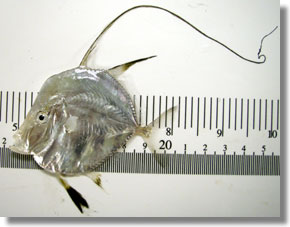
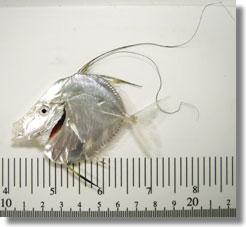 Two juvenile Mexican lookdown, Selene brevoortii, caught at Seal Beach on November 18, 2008.
(top) 63 mm standard length (SL); (bottom) 61 mm SL.
Two juvenile Mexican lookdown, Selene brevoortii, caught at Seal Beach on November 18, 2008.
(top) 63 mm standard length (SL); (bottom) 61 mm SL.
At Seal Beach, CA in November 2008 two Mexican lookdown, Selene brevoortii, juveniles were captured. The typical range for Mexican lookdown is from the southern tip of Baja California, Mexico to Panama, although adult specimens have been documented in south San Diego Bay during the 1997-98 El Niño event. This is the first documented occurrence of juvenile Mexican lookdown in California. The juvenile specimens represent an approximate 100 km northern range expansion from the Mexican lookdown's northernmost range boundary. Both specimens are now housed in the Los Angeles County Museum of Natural History fish collection (LACM 56886-1), and a scientific note has been published in the quarterly periodical California Fish and Game.